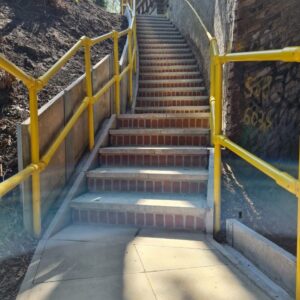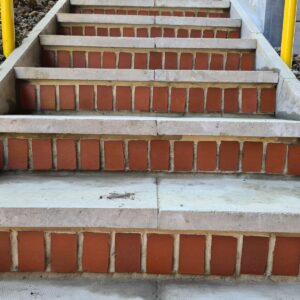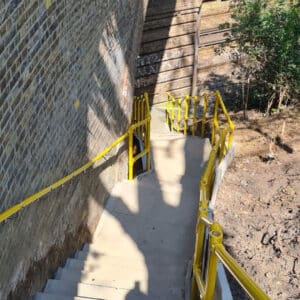Track Worker Safety Sites – Wickham Road, Retaining Structures
The project
Enable Design (formerly known as Equate Design) was awarded the contract to undertake designs proposing improvements to Track Worker Safety Sites. This involved providing scoping and design services to enable the upgrade of Network Rail-authorised access points in order to facilitate safe access for the workforce to undertake maintenance and upgrade works on the Network Rail infrastructure.
As a significant number of the sites were located on embankments, or in cuttings, step access was needed, and this required careful assessment of the slopes to determine the likelihood of existing slope stability issues, or whether the proposals would affect the stability of these slopes.
The challenge
To accurately determine the Factor of Safety (FOS) for slope stability, a comprehensive slope stability assessment is normally required, necessitating several deep boreholes to map the underlying strata. Without this, and in particular without knowledge of the dip (inclination) of the strata, any determined theoretical FOS is almost meaningless, particularly where slopes of relatively low existing FOS are concerned. For this project, the time constraints and prohibitive costs that would have been involved made such an approach unfeasible.
The solution
With multiple sites under consideration and insufficient budget to compete them all, it was agreed that the sites would be risk-assessed to identify slope stability risks. Due consideration was paid to available geotechnical information, including the earthwork condition reports, and only sites with the lowest risk were taken forward for design. Several sites were discounted at this stage.
Simultaneously, the access proposals were worked up to determine the vertical alignment. Where practicable, the stairs were designed to follow the natural slope, but for long slopes, a compliant stair requires intermediate landings, and this frequently requires cut or fill on the slope to facilitate a level area. These locations, and the general cut/fill requirements were again assessed to understand the likely effect on the slopes, and to determine if this was acceptable.
The Wickham Road Example
The Wickham Road access point upgrade was one of the most challenging sites and thus serves as a good example of what was achieved across the project as a whole. Existing access to the track here was via a series of timber and concrete stairs built on to the side of the steep embankment. Most of the steps were in poor condition and therefore required replacing. The scope called for new stairs with new handrails on both sides.The existing Wickham Road access point stairs were non-compliant to both NR/CIV/SD/370 and BS5935-1. To provide compliant stairs, an additional localised cut into the cutting slope was needed. In addition, to meet the standard, a new stairway had to be split into three flight sections with intermediate landings. The top section had an additional constraint due to a large London Plane tree: the head of the stairs had to be aligned with the existing stair to avoid undermining the tree roots. Sections of the underbridge section had to be moved towards the embankment to meet the headroom clearance under the arch bridge. The main objective was to support the cutting, since this could affect the stability of the embankment.
Two solutions were considered during the design stage. The first was to regrade the cutting to create a safe slope. This option was rejected due to the amount of regrading required and due to the fact that regrading would not prevent the top layers from flowing over.
The second, and preferred, option was to install a ballast-board retaining wall that would support the whole height of the cutting. The wall was designed in accordance with IPS&E/EPF99/CIVILS/020. This solution proved both economical and sufficient to retain the cutting up to 900mm.
The Team
- Engineering Manager
- Design Manager
- Survey Engineers
- Civil Engineers
The deliverables
The works across the various sites consisted of the following elements:
- Topographical survey – prior to any design works, site is scoped and surveyed.
- Earthwork risk assessments undertaken, considering site topography, geological mapping data, existing known slope stability issues (at and adjacent to the site), and the proposed groundworks for the preferred solution.
- The design of various access points by Enable Design, ensuring compliance with the standards.
- Designs developed to provide access stairway to the track, ensuring coordination with other elements like track layout and existing assets.
- The design focused on providing a compliant solution – a stairway with intermediate landings providing safe point to stop, if required , – significantly reducing the risk of falls.
- Enable Infrastructure (formerly BCM Construction), the main contractor, coordinated the installation of the new flights of stairs, installation of yellow GRP handrailing and works to the existing boundary fencing and gates.
- In addition to the above items, retaining structures (ballast-board retaining walls) were installed to resolve the embankment support and slope stability issues.
Gallery



Find out how we can help you
If we can help you in any way, please do get in touch. In order that we can assist you efficiently, please click on the link below. Alternatively, you can call us on 020 4566 9616.
Get in Touch